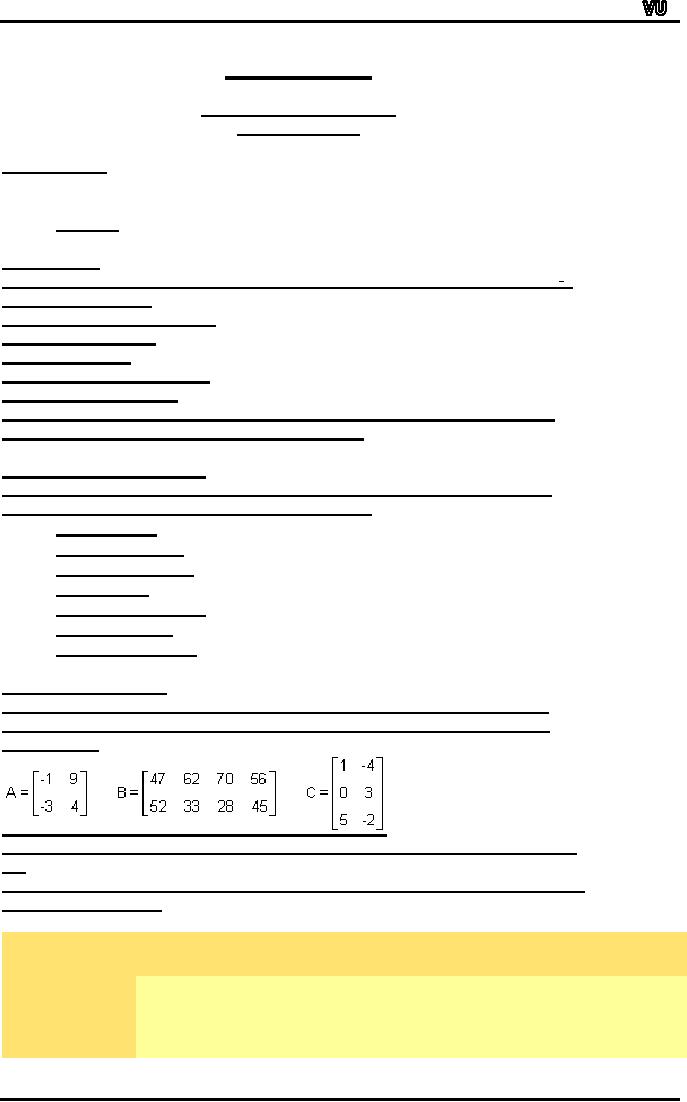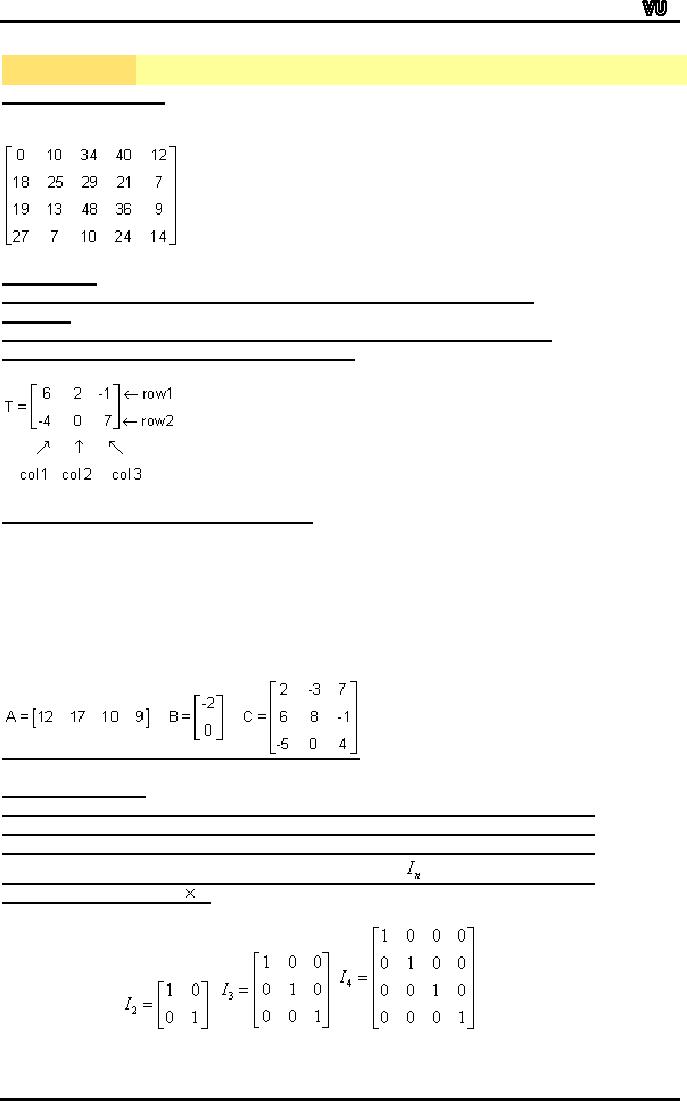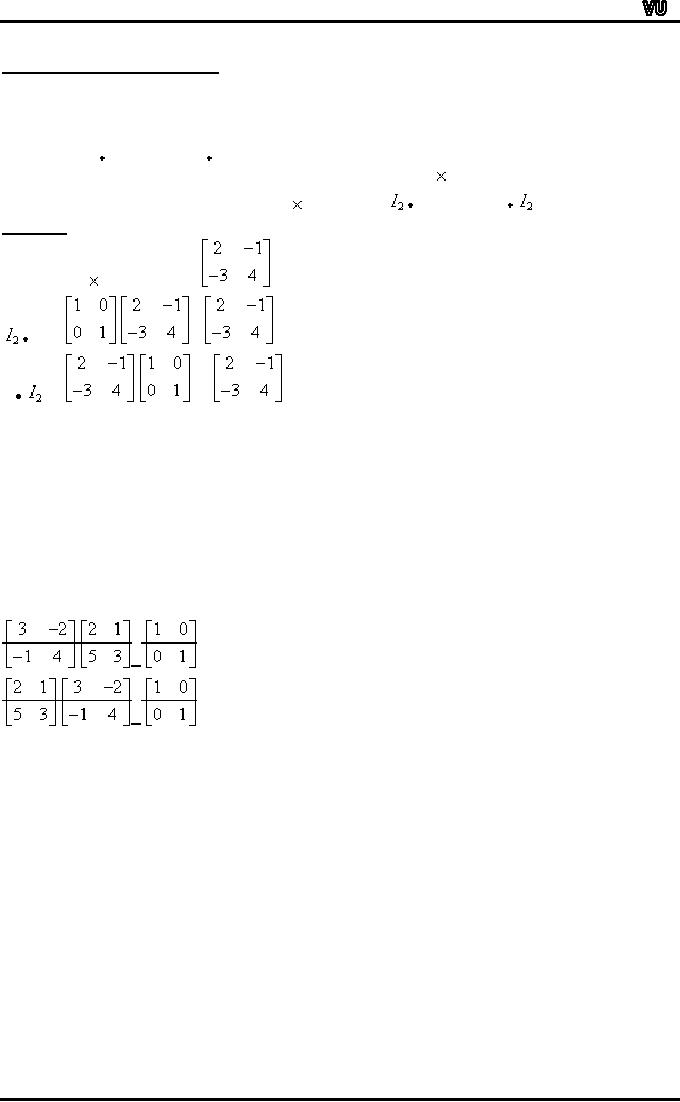 |
Matrix and its dimension Types of matrix:TYPICAL APPLICATIONS |
| << Applications of Basic Mathematics:NOTATIONS, ACCUMULATED VALUE |
| MATRICES:Matrix Representation, ADDITION AND SUBTRACTION OF MATRICES >> |

MTH001
Elementary Mathematics
LECTURE #
19
Matrix
and its
dimension
Types of
matrix
OBJECTIVES
The
objectives of the lecture
are to learn about:
∑
Matrices
QUESTIONS
Every
student wonders why he or she
should study matrices. There
are manty
important
questions:
Where
can we use
Matrices?
Typical
applications?
What
is a Matrix?
What
are Matrix
operations?
Excel
Matrix Functions?
There
are many applications of
matrices in business and
industry especially
where
large amounts of data are
processed daily.
TYPICAL
APPLICATIONS
Practical
questions in modern business
and economic management can
be
answered
with the help of matrix
representation in:
∑
Econometrics
∑
Network
Analysis
∑
Decision
Networks
∑
Optimization
∑
Linear
Programming
∑
Analysis
of data
∑
Computer
graphics
WHAT
IS A MATRIX?
A
Matrix is a rectangular array of
numbers. The plural of
matrix is matrices.
Matrices
are usually represented with
capital letters such as
Matrix A, B, C.
For
example
The
numbers in a matrix are
often arranged in a meaningful
way. For example,
the
order
for school clothing in
September is illustrated in the
table, as well as in
the
corresponding
matrix.
Size
Youth
S
M
L
XL
Sweat
Pants
0
10
34
40
12
Sweat
Shirts
18
25
29
21
7
Shorts
19
13
48
36
9
Page
129

MTH001
Elementary Mathematics
T-shirts
27
7
10
24
14
The
data in the above table
can be entered in the shape
of a matrix as follows:
DIMENSION
Dimension
or Order of a Matrix = Number of
Rows x Number of
Columns
Example
Matrix
T has dimensions of 2x3 or
the order of matrix T is
2x3. `◊' is just
the
notation,
it do not mean to multiply
both of them.
ROW,
COLUMN AND SQUARE
MATRIX
Suppose
n = 1,2,3,4,.......
A
matrix with dimensions 1xn
is referred to as a row
matrix
For
example, matrix A to the
right is a 1x4 row
matrix.
A
matrix with dimensions nx1
is referred to as a column
matrix.
For
example, matrix B in the
middle is a 2x1 column
matrix.
A
matrix with dimensions nxn
is referred to as a square
matrix.
For
example, matrix C is a 3x3
square matrix.
IDENTITY
MATRIX
An
identity matrix is a square
matrix with 1's on the
main diagonal from the
upper
left
to the lower right and
0's off the main
diagonal. An identity matrix is
denoted
as
I. Some examples of identity
matrices are shown below.
The subscript
indicates
the size of the identity
matrix. For
example,
,
represents an identity
matrix
with dimensions n n.
Page
130

MTH001
Elementary Mathematics
MULTIPLICATIVE
IDENTITY
With
real numbers, the number 1
is referred to as a multiplicative
identity
because
it has the unique property
that the product a real
number and 1 is that
real
number. In other words, 1 is
called a multiplicative identity
because for any
real
number
n, 1 n = n and n 1=n. With
matrices, the identity
matrix shares the
same
unique property as the
number 1. In other words, a 2 2
identity matrix is a
multiplicative
inverse because for any 2 2
matrix A,
A
= A and A
=A
Example
Given
the 2 2 matrix, A =
A=
=
A
.=
=
Work
r1c1
= 1(2) + 0(-3) = 2
r2c1
= 0(2) + 1(-3) = -3
r1c1
= 2(1) + -1(0) = 2
r2c1
= -3(1) + 4(0) = -3
r1c2
= 1(-1) + 0(4) = -1
r2c2
= 0(-1) + 1(4) = 4
r1c2
= 2(0) + -1(1) = -1
r2c2
= -3(0) + 4(1) = 4
where
'r' is for row and
'c' is for column.
=
=
Page
131
Table of Contents:
- Recommended Books:Set of Integers, SYMBOLIC REPRESENTATION
- Truth Tables for:DE MORGANíS LAWS, TAUTOLOGY
- APPLYING LAWS OF LOGIC:TRANSLATING ENGLISH SENTENCES TO SYMBOLS
- BICONDITIONAL:LOGICAL EQUIVALENCE INVOLVING BICONDITIONAL
- BICONDITIONAL:ARGUMENT, VALID AND INVALID ARGUMENT
- BICONDITIONAL:TABULAR FORM, SUBSET, EQUAL SETS
- BICONDITIONAL:UNION, VENN DIAGRAM FOR UNION
- ORDERED PAIR:BINARY RELATION, BINARY RELATION
- REFLEXIVE RELATION:SYMMETRIC RELATION, TRANSITIVE RELATION
- REFLEXIVE RELATION:IRREFLEXIVE RELATION, ANTISYMMETRIC RELATION
- RELATIONS AND FUNCTIONS:FUNCTIONS AND NONFUNCTIONS
- INJECTIVE FUNCTION or ONE-TO-ONE FUNCTION:FUNCTION NOT ONTO
- SEQUENCE:ARITHMETIC SEQUENCE, GEOMETRIC SEQUENCE:
- SERIES:SUMMATION NOTATION, COMPUTING SUMMATIONS:
- Applications of Basic Mathematics Part 1:BASIC ARITHMETIC OPERATIONS
- Applications of Basic Mathematics Part 4:PERCENTAGE CHANGE
- Applications of Basic Mathematics Part 5:DECREASE IN RATE
- Applications of Basic Mathematics:NOTATIONS, ACCUMULATED VALUE
- Matrix and its dimension Types of matrix:TYPICAL APPLICATIONS
- MATRICES:Matrix Representation, ADDITION AND SUBTRACTION OF MATRICES
- RATIO AND PROPORTION MERCHANDISING:Punch recipe, PROPORTION
- WHAT IS STATISTICS?:CHARACTERISTICS OF THE SCIENCE OF STATISTICS
- WHAT IS STATISTICS?:COMPONENT BAR CHAR, MULTIPLE BAR CHART
- WHAT IS STATISTICS?:DESIRABLE PROPERTIES OF THE MODE, THE ARITHMETIC MEAN
- Median in Case of a Frequency Distribution of a Continuous Variable
- GEOMETRIC MEAN:HARMONIC MEAN, MID-QUARTILE RANGE
- GEOMETRIC MEAN:Number of Pupils, QUARTILE DEVIATION:
- GEOMETRIC MEAN:MEAN DEVIATION FOR GROUPED DATA
- COUNTING RULES:RULE OF PERMUTATION, RULE OF COMBINATION
- Definitions of Probability:MUTUALLY EXCLUSIVE EVENTS, Venn Diagram
- THE RELATIVE FREQUENCY DEFINITION OF PROBABILITY:ADDITION LAW
- THE RELATIVE FREQUENCY DEFINITION OF PROBABILITY:INDEPENDENT EVENTS